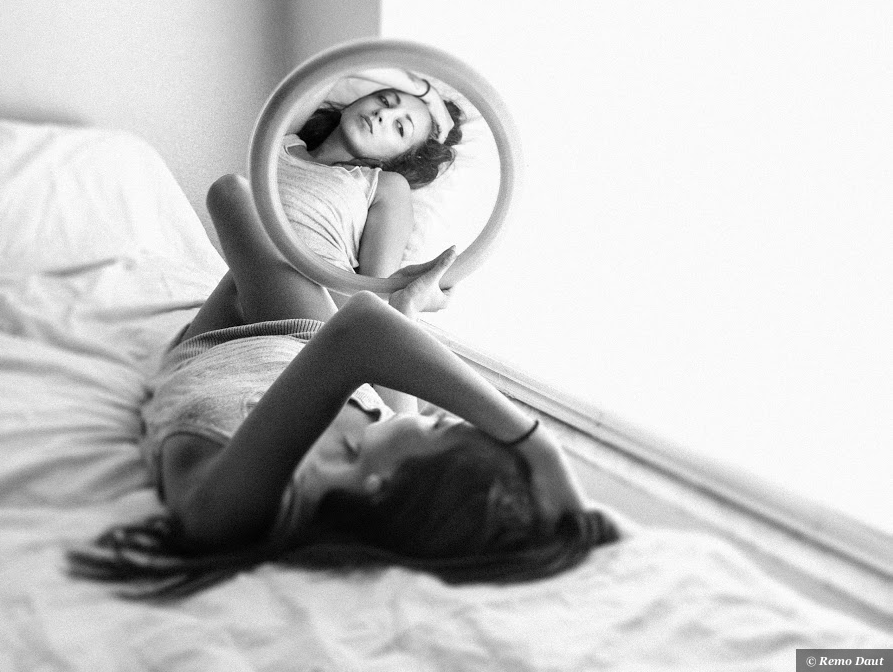I roll over. It’s 6:00 am. I run my hands over my belly, my breasts, my face.
My skin is soft. I think that right before I think the inevitable corollary, “How is that possible? I’m so old.”
I lay there and wonder how fat I’ll feel today—if, when I stand up, I will float or if I’ll lumber.
I wrangle my way upright. It isn’t easy. I’m healthy and 44 (not old/not young) and a yoga teacher, but my body hurts.
My back is a comedy of misalignment, the vertebrae barely hanging onto some semblance of integrity, like an old beater you see creaking down the street in a cloud of exhaust, the rearview mirror attached with duct tape, the driver’s side window permanently down.
Then there’s the broken arm I’m trying to heal, the fractured hand—and let’s not forget my brain, which has been diagnosed as grievously misfiring chemicals for as far back as 30 years. On this humid, still, summer morning, the kind of morning that most people will rise to greet like a dog greets her human, I can already sense a dopamine deficit, a grey woolen blanket tucked in around my heart.
I pass by the bathroom mirror on the way to the toilet. As always, I glance at my profile, avoiding looking at my face— an unseemly affair this early in the morning—and focusing on my abdomen. The verdict is always the same; relatively thin, but that’s weird, because I can feel myself expanding like Veronica Blueberry, stretching the very limits of my flesh with unwanted volume.
This appearance of thinness must be because of the light, I conclude, or the angle.
I know that there is no possibility that I am truly thin.
I get dressed to work out as quickly as I can, carefully avoiding my reflection in the closet mirror. This is a “bad” mirror, and if I let myself look the whole day could easily go off the rails.
I pull on my bike shorts, wondering if they will squeeze my flesh in a more or less attractive way than yesterday. I tug at the fabric, trying to find the least offensive position for everything; tuck in the waist flesh, cover the thighs. Then I rifle through my closet for the baggiest shirt I own. I know baggy shirts don’t make anyone look good, including me, but they are wonderful invisibility cloaks and that’s what I really want: to be invisible.
Soon, I’m out in the woods with my dogs, and aside from the worry that I might see someone I know (someone who will pass me and whisper to her friend, “She looks like she’s put on a bit of weight, doesn’t she?”), I am free.
Free from this boring preoccupation that has wrapped it’s arms around me from the dawn of my consciousness. This shameful first world problem I carry around like a snake coiled under my flesh, that I try so hard to contain, but which is always, always on the verge of crawling out and letting itself be seen.
I know I am not my body, but my body does contain me, and everything I sense must be experienced through the filter of my flesh. It follows, then, that the problem is not the flesh itself, but the filter.
Change my thinking and whoosh, the problem disappears. Right?
My yogic training has taught me that the answer lies in observation and compassionate acceptance. And I have gotten better at getting still and observing these delusions as they pulsate through my mind. I have even accepted that this is a subject that will color the rest of my life, that part of the meaning of this life for me (for a reason I may never know) is to tackle this monster from every conceivable angle even if I believe that the battle is un-winnable.
The piece I am clearly missing is compassion. Self care. The waves of hatred that follow my surreptitious peeks into any reflective surface I happen to pass by, either for what is reflected back or for the fact that I looked in the first place, are poisonous waters, polluted and toxic. I need a huge environmental clean up, as it were.
Writing these things out helps—writing out the pain. Seeing these words here in black and white binds them with a sense of gravity, but also with lightness; I can contain these feelings, albeit temporarily, on this page.
I guess an under recognized part of compassion is bravery—the bravery to look whatever is ugly (really ugly, not ugliness reflected) in the face and say, “I see you there. I will not run. I will not shut down. I see you as the shifting shadow you are, and I see the light that still shines through around your edges even at your blackest.”
I can be still. I can be brave. I can be kind.
If I can be these things often enough, perhaps I can also be beautiful— beautiful in a way that transcends my body and arcs out like a multicolored illuminated beam, which people sometimes call a rainbow, and encapsulates the wisdom of natural wonders and unwavering conviction.
Love elephant and want to go steady?
Sign up for our (curated) daily and weekly newsletters!
Editor: Renée Picard
Photo: Remo Daut at Pixoto











Read 4 comments and reply